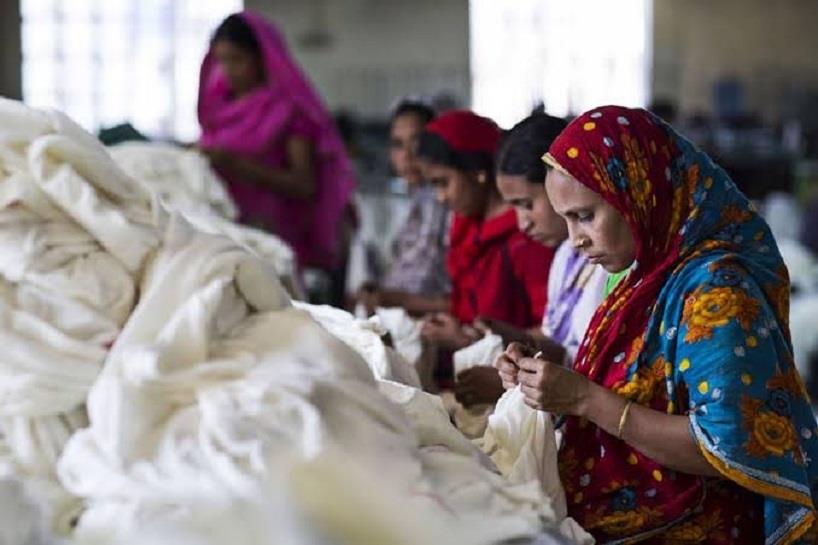(MENAFN- Kashmir Observer)

Workers sew garments on the production line of a garment factory in Dhaka, Bangladesh. (Photographer: Jeff Holt/Bloomberg)
What makes Bangladesh India's largest export destination?
By Ozair Islam
IN Fiscal Year 2022, Bangladesh is expected to be India's fourth-largest export destination jumping from the fifth place it is currently holding. This is definitely a landmark for the Indo-Bangladesh relations which began on 6 December 1971 with India's recognition of Bangladesh as an independent state. It is a time-honored decision to analyze the factors that have made Bangladesh to be in the list of top five export destinations of India and how both countries can generate more benefits from this economic engagement.
According to the available data till October, during the first seven months of fiscal year 2022, exports from India to Bangladesh increased 81 percent over the same time period in the previous year to USD7.7 billion. This makes Bangladesh the fourth largest export destination of India after the USA, UAE and China respectively. Sri Lanka and Cambodia may also follow Bangladesh's footsteps to make their market more attractive to Indian investors.
If this export trend remains constant, then Bangladesh is most likely to achieve the rank as India's fourth largest export market from the fifth position it is holding from last year. Analysts and experts were surprised, in fiscal year 2020, when Bangladesh directly jumped to the fifth position from the ninth position in India's export profile.
What makes Bangladesh such an attractive export destination for India?
This has become possible because of Bangladesh's economic boom which has ultimately contributed substantially to India's export growth to Bangladesh. Bangladesh has demonstrated extreme economic success and growth in the past decades especially among the South Asian countries. The RMG sector, which is responsible for almost 80 percent of the total export earnings, worked as a main engine of economic growth and development. According to the Global Knowledge Partnership on Migration and Development (KNOMAD), Bangladesh has become eighth largest remittance earner in 2020. In 2020, the remittance Bangladesh earned from its expatriates accounted for 6.6% of GDP. This remittance inflow ensures stable household income, increased consumption level and improved living standard of the people. Economists also predict that Bangladesh may even surpass India in terms of per capita income in the coming year. Sri Lanka and Cambodia may learn from Bangladeh's macroeconomic policies to manage their economy for further growth.
In the Fiscal Year 2020-21, the Per Capita Income (PPI) in Bangladesh was $2,554 and the Gross Domestic Product (GDP) of Bangladesh has increased to $409 billion . If we analyze the GDP and PPI of Bangladesh over the last 10 years, we will see a growing trend which ultimately indicates that the purchasing power of the people of Bangladesh has increased over this timeframe. When PPI increases, demand for goods and services increases which makes Bangladesh an attractive market not only for internal companies but also for the foreign companies.
How India penetrated into Bangladesh's market?
There are a number of factors that helped Indian companies to successfully penetrate into Bangladesh's market. The shared civilizational bonds, common history and cultural and social affinity bought Bangladesh and India closer. People of these countries have similar taste in foods and other day-to-day necessities which made Indian companies read the psychology of Bangladeshi consumers. On the other hand, Indian media is widely broadcast in Bangladesh which also created huge demand for Indian goods in Bangladesh through successful marketing promotion and advertising. Besides, Indian companies grabbed the Bangladesh market perfectly with quality products and affordable prices. Noteworthy to mention here, the major goods exported to Bangladesh from India, during April-October 2021, are cereal, cotton, electricity, vehicle parts, and mechanical appliances.
In Fiscal Year 2019-20, the bilateral trade between India and Bangladesh crossed $10 billion where India's exports to Bangladesh were $8.2 billion and Bangladesh's exports to India $1.26 billion. This data shows that there is a huge trade deficit for Bangladesh which should be addressed immediately by both countries especially by India. Otherwise, these economic ties will be questioned by the critics dubbing it as 'trade imbalance'. Besides, India, as a South Asian Giant, should provide different types of trade facilities, such as tariff reduction, to create a level playing field for Bangladesh. The countries may undertake a bilateral comprehensive economic partnership agreement (CEPA) to address the aforementioned issue and to have greater bilateral engagement. Not to forget, without addressing issues of tariff and non-tariff barriers, the countries cannot expect to sustain the growth in their economic ties for a long time.
Ozair Islam is a freelance writer and columnist. He can be reached at [email protected]
MENAFN11012022000215011059ID1103522341
Legal Disclaimer:
MENAFN provides the information “as is” without warranty of any kind. We do not accept any responsibility or liability for the accuracy, content, images, videos, licenses, completeness, legality, or reliability of the information contained in this article. If you have any complaints or copyright issues related to this article, kindly contact the provider above.